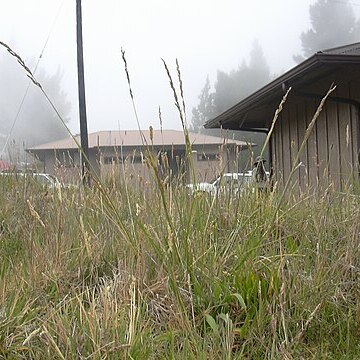Perennial (sometimes annual in hard sites), caespitose. Culms 38–200 cm high, smooth. Young shoots intravaginal. Leaves: basal sheath margins free; ligule a minute rim, 0.4–0.9 mm long; auricles narrow, ciliate; blade flat basally and folded towards apex, subulate to linear, 9.5–39 cm long, 4–14 mm wide, adaxially glabrous. Panicles somewhat contracted, 11–34.5 cm long. Spikelets 7.7–15.3 mm long, with 3–7 bisexual florets. Glumes: lower glume 3.4–5.9 mm long, 1 or 3-nerved; upper glume 4.3–6.8 mm long. Lemma dorsally compressed, 6.4–9.4 mm long, acute, shortly awned, obscurely 5-nerved, minutely scabrous on midnerve and marginal nerves; awn subapical, 0.9–4.3 mm long. Caryopsis obovoid.
Densely tufted, robust perennial 800-2 000 mm high; rhizomatous; sheaths glabrous, not breaking into fibres. Leaf blade 100-600 x 3-12 mm; auricles (best seen in young leaves) well developed, undulating with ear-like extension on either side, to 5 mm wide, minutely hairy; ligule to 2 mm long. Inflorescence 100-500 mm long, open to contracted, lanceolate to ovate, branches erect, stiff ±adpressed to central axis; branches smooth or with scattered prickles; spikelets congested. Spikelet 10-18 mm long; 3-10-flowered; glumes ±equal, lower 1-nerved, upper 3-nerved; lemma acute or awned; awn 0.5-4.0(6.0) mm long; anthers 3-5 mm long.
Much like no. 1 [Festuca pratensis Huds.], often taller, to 2 m; old sheaths pale stramineous, only tardily disintegrating; blades coarse and thick, prominently ridge-veined above, 4–10 mm wide, with ciliate auricles; first node of the panicle with 2–3 branches, each with 5–15 spikelets, these mostly 3–6-fld; first glume (3–)4–6 mm, the second (4–)5–9 mm; lemmas 7–8.5+ mm, usually scabrous distally, the awn 0.3–2(–4) mm; 2n most often = 42, sometimes 28, 56, 63, 70. Native of Europe, widely planted in our range and elsewhere in the U.S., and readily escaping. (F. elatior, a rejected name)
Tufted perennial, 0.8-2.0 m high, rhizomatous; sheaths glabrous, not breaking into fibres. Leaf blade 100-600 x 3-12 mm; auricles (best seen in young leaves) well developed, up to 5 mm wide, minutely hairy; ligule an unfringed membrane up to 2 mm long. Inflorescence an open to contracted panicle, 100-500 mm long, lanceolate to ovate, nodding or erect. Spikelets 10-18 mm long, laterally compressed; glumes ± equal, 1-nerved. Florets 3-10; lemma entire, acute or awned, rounded on back, at least at base, awn 0.5-4.0(-6.0) mm long; anther 3-5 mm long. Flowering time Sept.-Apr.
Perennial; up to 2 m high; rhizomatous and tufted. Leaf blades 100-600 x 3-12 mm; leaf sheaths not breaking into fibres; sheaths glabrous; leaf auricles well developed; up to 5 mm wide; usually as a large undulating flange with an ear-like extension on either side of sheath (but may be absent as it breaks off easily); ligules up to 2 mm long. Flowers: panicle narrowly ovate to ovate; 100-500 mm long; nodding; lowest branches < 1/2 length of central axis; spikelets 10-18 mm long; spikelets 3-10-flowered; lemmas acute or awned; awn up to 4 mm long.
Tufted perennial; culms 45–180 cm. high.. Leaf-blades 10–60 cm. long and 3–12 mm. wide, flat, with minutely hairy falcate auricles; leaf-sheaths glabrous.. Panicle lanceolate to ovate, 10–50 cm. long, loose or contracted.. Spikelets closely 3–10-flowered, elliptic to oblong, 10–18 mm. long; lower glume 3–6 mm. long, the upper 4.5–7 mm. long; lemmas narrowly ovate, 6–9 mm. long, awnless or with a fine bristle up to 4 mm. long from just below the hyaline tip; palea as long as the lemma; ovary glabrous; anthers 3–4 mm. long.
A grass. It keeps growing from year to year. It grows 2 m tall. It forms dense tufts. The leaves have rough edges and are 1 cm wide. The flower heads have narrowly oval spikelets 1-2 cm long.
Perennial to 2 m. Leaves linear-lanceolate, dark green, auricles well developed. Spikelets in a nodding panicle, 10-18 mm long, awn to 4 mm.

